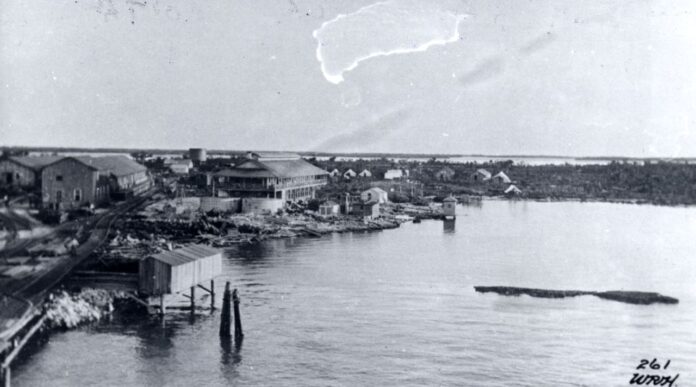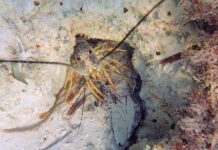
Last week I wrote about the Middle Keys, or how Key West and the Upper Keys often overshadow the Middle Keys. There is absolutely amazing history in the Middle Keys, and as I discover more, the thing I always say just rings truer and truer: It is hard to tell a Key West, Islamorada, Marathon or Key Largo story without telling a larger story about the Florida Keys.
While digging through old newspapers, I stumbled upon a story that combined many of last week’s column elements, including the Spanish land grants, circa 1850 Key Vaca, and Conch Town. The story was published in the Jan. 19, 1858 edition of the Charleston Daily Courier. The headline was “Key West”; the byline was Messrs. Editors Courier –. Messrs is the plural of Mr. The first-person narrative tells the story of a visit to Key West and the Middle Keys, and, in the end, the writer identifies himself simply as W.P.
W.P. left Charleston, South Carolina, on Dec. 4, 1857, aboard the steamer Isabel and arrived in Key West on Dec. 6. The purpose of his visit, as best as can be ascertained by his account, was to visit the island chain and see some of the islands in the Middle Keys, of which he states he had a one-third ownership. One of the other owners is not identified, but the other is referenced as Mr. H., a deputy collector at Key West.
Mr. H. could reference Charles Howe, a collector of customs in Key West who owned or used to own the islands addressed in the newspaper column. Howe left a historical footprint in the Upper Keys, the Middle Keys and in Key West. He was semi-famously living on Indian Key with his family during the island’s infamous 1840 attack. The Howe family home was one of the few structures not set on fire by the Indians that morning. He later moved to Key West and, by 1845, was working as the collector of customs.
Charles Howe also once owned several islands in the Middle Keys, islands like Key Vaca that can be connected to the Spanish land grants. The land grants encouraged pioneer settlement, much like the U.S. version, the Homestead Act of 1862. In 1814, when Spain still governed these islands, several Middle Keys, Key Vaca, Boot, Viper (Long), Duck, and Knight Keys, were deeded to a Spanish friar named Francisco Ferreira.
Ferreira apparently sold Duck Key to Soloman Snyder on June 11, 1823. The collection of islands, including Duck Key, was also sold to Ferreira’s friend Isaac Cox for $3,000. Cox, in turn, sold the islands to Charles Howe in 1827 for $1,500 – including Duck Key, where Howe lived for several years and developed salt ponds before moving to Indian Key.
Sources also indicate that Charles Howe sold “Key Vacas” to Charles Edmonton on June 1, 1832. In any case, according to the story, Mr. H. “chartered a beautiful little yacht schooner, called the Foary (spelling might be off because the newspaper print is blurry), and we having added to the stores, as well as a first-rate cook and steward, sailed to visit the Keys we were interested in, on the morning of the 12th of December.”
About the partnership with Mr. H., he wrote: “Our titles (which are indisputable, dating as far back as a grant by the Spanish Government to an old Spanish fisherman, and confirmed at Washington city after the cession of Florida to the United States) commenced with Knights’ Key, containing about one hundred and twenty-five acres of arable land, and has a comfortable house with a good cistern.”
According to Mr. P., the writer, “We sailed on rear of our Key Vaccas, supposed to contain 1,500 acres; also Torch Key, smaller, but very fine soil, on which we have about 10,000 hemp plants; then Fat Deer Key, about 1,000 acres – no plants here, but plenty of the animal it is named after, indeed most of these Keys have plenty of deer on them. Next, Long Point Key, well suited for a cocoanut plantation, has about 800 acres. Crawl Key, Grassy Key about 1,500 acres, land good and many springs or rock wells of fresh water, which never dry up.”
The firsthand account included ideas being discussed for future plans for Key Vaca.
“Next day we sailed down between the Reef and the front of our Islands, as far as Thomas’ Harbor …” Thomas’ Harbor likely refers to what is called the Toms Harbor Keys, located between Duck Key and Grassy Key.
He continued, “… and the following morning visited Jacob’s Harbor, or Conch Town, a considerable settlement on the front of our Key Vaccas, consisting of about thirteen families, some of whom have good garden spots, the soil being good and producing well which is the case with most of these Keys. The several owners of our islands have it now under consideration to lay off a town at or near this spot, and sell our lots, where invalids or others could spend a few of the cold winter months and at little expense – two or more families joining and chartering a vessel, and bringing their framed buildings and provisions.”
It does not appear that the owners followed through with their plan – or maybe, more digging will reveal that they did. In any case, it was not until the turn of the century that the railroad town of Marathon developed and became the heart of the Middle Keys.





















